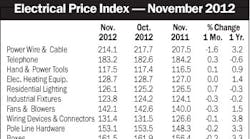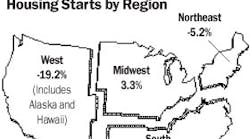Latest from Mag
Construction professionals can breathe a sigh of relief. The U.S. construction industry should post another strong showing in 2007, according to several economists who spoke at the McGraw-Hill Construction Outlook 2007 Forecast, held Oct. 27 in Washington, D.C.
Cost increases in building materials should moderate and the nonresidential segment of the construction market should make up for the decline of the housing market. Robert Murray, vice president of economic affairs, McGraw-Hill Construction, New York, said total construction would remain very healthy next year but would decline 1 percent to $668 billion.
The decrease in the housing market is responsible for a large share of this decline, because single-family housing accounts for nearly 40 percent of all construction. Housing starts have dropped 25 percent from their record high last year. Murray said if the decline he expects next year in the single-family housing market was taken out of his 2007 forecast, total construction sales would be up 3 percent. According to the 2007 McGraw-Hill Construction Outlook, the market sectors leading the construction industry in 2007 will be educational buildings with a 6 percent increase to 243 million square feet; office construction with a 5 percent increase to 197 million square feet; and airport construction with $2.3 billion in new construction.
The relatively low level on construction anticipated in the industrial market reflects the new realities of global manufacturing. Although new construction of manufacturing buildings is expected to grow 11 percent to 91 million square feet, that’s actually a low level compared to years past. As a point of reference, during the 1990s annual square footage of new manufacturing construction only dipped below the 100-million-square- foot mark during the 1991-1992 recession. During the late 1980s, it hovered near the 150-million-square-foot mark.
Store construction has been one of the most active markets, but it’s expected to decline 7 percent to 278 million square feet. Murray still anticipates substantial building from five major players: Wal-Mart, Home Depot, Lowe’s, Target and Kohl’s.
In the utility market, the amount of construction has fluctuated wildly over the past few years. In 2007, utility construction is expected to drop to $9.4 billion, a 20 percent decline from 2006. But this year’s amount of utility construction represents a 65 percent increase from 2005.
Meeting attendees were quite interested in what John Mothersole had to say about increases in building material costs. Mothersole, principal of industry practices, Global Insight, Waltham, Mass., has been tracking the meteoric rise in copper, steel, PVC and other key materials for the past few years and is the leading expert on the topic. He expects overall construction materials costs to be up 6 percent to 7 percent in 2006, but says that rate of growth will moderate in 2007. Mothersole said Global Insight has gotten more calls on copper pricing than any other commodity. He expects copper pricing to decline in 2007.
All of the economists who gave presentations at the conference were bullish about 2007’s economic fortunes. David Wyss, chief economist, Standard & Poor’s, New York, said despite the soft housing market, the U.S. economy has the resilience to continue expanding in the near future. Things are pretty darn good,” he said. “In the 1970s and 1980s we would have killed for an economy like this. Comsumer spending is the heart and soul of this expansion,” he said. We did it the American way — living beyond our means.”
He had some concerns about the long-term growth prospects of the world’s economy. China has become the fastest-growing economy on earth, and he said it now accounts for 31 percent of world growth, compared to 15 percent for the United States. But Wyss said a bigger red flag is the aging of the world’s population because of the burden retirees place on health-care systems and social security systems. By 2020, more than 50 percent of the citizens of France, Italy and Japan will be older than 65 years old. In contrast, less than 30 percent of U.S. citizens will be at retirement age at that time.

